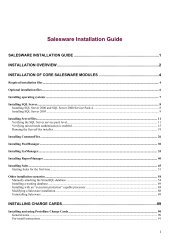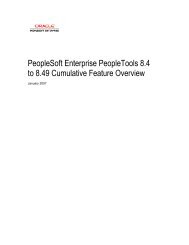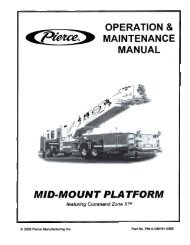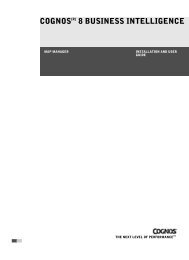COGNOS Business Intelligence Series 7
pes.pdf
pes.pdf
You also want an ePaper? Increase the reach of your titles
YUMPU automatically turns print PDFs into web optimized ePapers that Google loves.
Chapter 2: Configure Servers<br />
4. Click the Environment Variables button.<br />
5. Check the System Variables list.<br />
Change Display Settings with Style Sheets<br />
PowerPlay Enterprise Server uses a cascading style sheet (CSS) to describe how Web pages are<br />
presented in users' Web browsers. You can use the style sheet to customize the look of your pages.<br />
For example, you can reverse the font and background colors of table headings for emphasis. For<br />
information about cascading style sheets, visit the World Wide Web Consortium (W3C) Web site<br />
at www.w3.org.<br />
The styles are defined in the file ppweb.css, which the PowerPlay server refers to when<br />
constructing each HTML page. This file contains a set of default styles and a description of what<br />
those styles affect.<br />
The style sheet definitions replace display settings for cubes that you set in PowerPlay Enterprise -<br />
Server Administration.<br />
The only supported method to change display settings in the Enhanced interface of PowerPlay<br />
Web is to edit the .css file.<br />
Steps<br />
1. Ensure that you back up ppweb.css before editing it.<br />
2. Open the file ppweb.css in a text editor.<br />
It is located in the webcontent/ppwb directory.<br />
3. Edit the properties to achieve the view that you want.<br />
Descriptions in commented text precede each block.<br />
4. Save and close the file.<br />
5. Ensure that the owner of the web server has read access to ppweb.css.<br />
6. Refresh the browser to see the resulting changes.<br />
Notes<br />
• Web browsers support CSS in different ways. You should test your style sheets with different<br />
Web browsers to be sure you have the correct effect.<br />
• You should not delete ppweb.css to disable styles, because some browsers do not function<br />
properly when a style sheet is referenced but not found. Instead, comment out the styles you<br />
don't want, or load a copy of the original ppweb.css file.<br />
Specify the Portal to Which Reports are Published<br />
You can specify that reports published from PowerPlay Enterprise - Server Administration or<br />
PowerPlay Web are saved to one of the following portals:<br />
• Upfront<br />
Upfront is the Web interface to Cognos enterprise applications and other Web data. In<br />
PowerPlay Web you can save your report as a primary NewsItem in an Upfront NewsBox.<br />
For more information about Upfront, see the Web Portal User Guide.<br />
• Cognos Connection<br />
Cognos Connection is the portal to Cognos ReportNet or Cognos 8, the Web-based reporting<br />
solution. The Cognos Connection portal provides a single access point to all corporate data<br />
available in ReportNet or Cognos 8.<br />
For information about publishing reports from PowerPlay Enterprise - Server Administration, see<br />
"Publish to Upfront" (p. 49) or "Publish to Cognos ReportNet or Cognos 8" (p. 51).<br />
For information about publishing reports from PowerPlay Web, see the PowerPlay Web User’s<br />
Guide.<br />
Steps<br />
1. In PowerPlay Enterprise - Server Administration, select a server.<br />
18 Cognos PowerPlay (R)
















